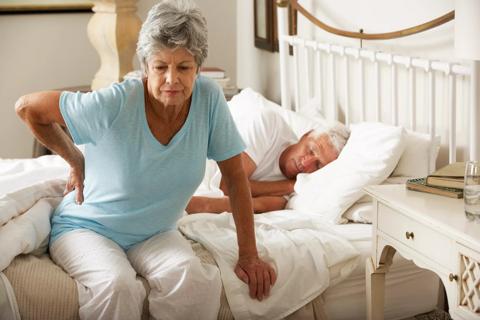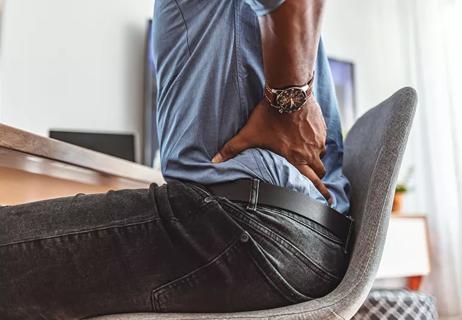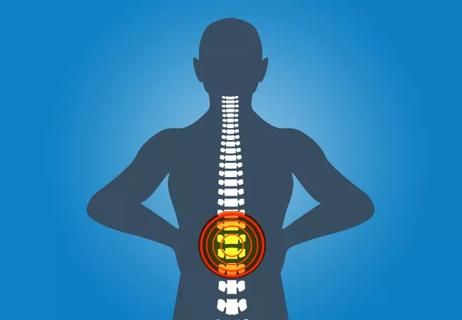Back spasms, shingles and disk conditions can all feel like a burning sensation

There’s nothing that can slow you down quite like back pain. And when that pain feels like there’s a hot iron being pressed into your back, you’ll want to know what’s causing it — and how to make it stop.
Advertisement
Cleveland Clinic is a non-profit academic medical center. Advertising on our site helps support our mission. We do not endorse non-Cleveland Clinic products or services. Policy
Your spine is a complicated and vital structure. It’s what lets you walk, twist and bend. It gives you shock absorption to move about. And it protects some really vital structures, like your spinal cord and nerves. It’s an intricate design composed of nerve fibers, muscles, bones, joints and more.
If any one of those components goes out of whack, well … your body starts screaming for help in any way it can. It tingles. It goes numb. It feels like shooting pain, stabbing pain and, yes, BURNING pain.
“Back pain, and pain in general, is your body’s way of telling you to protect yourself,” says pain management specialist Teresa Dews, MD. “Pain is your body is saying, ‘Hey, pay attention. There’s something happening here.’”
We talked with Dr. Dews about what your burning back pain is trying to tell you, and for her advice on how you should respond.
Our nervous system is responsible for sending a host of messages all around our bodies. It sends messages that tell us what’s going on inside of our bodies, as well as what’s going on in the world. For example, we experience pressure when we hold hands or hug. It tells us that it’s cold when we’re standing out in the snow. And it tells us when we’re feeling pain.
Advertisement
But what pain feels like and how intense it feels can vary from person to person. So, your burning back pain may be someone else’s tingling back pain — even if the pain is stemming from the same condition.
“There’s a whole spectrum of sensations that are activated in your nervous system and recognized by your brain,” Dr. Dews says. “One person’s nervous system may activate nerve fibers that communicate temperature, like burning. But the same thing could activate a pressure sensation in another person, and then another person, it could be more like a tingling sensation or vibration.”
So, if you have what feels to you like a burning pain in your back, that tells you there’s something wrong. But a burning pain doesn’t necessarily explain the reason for the pain.
Dr. Dews advises that your first course of action when you feel pain in your back, including burning, stabbing, tingling and so forth, is to take a look at the area. (Use a mirror or ask a friend to take a look if you can’t see it yourself … please be careful to not hurt yourself more by trying to take a peek!)
Take note of whether you see a rash or other change to your skin and what it looks like. Red? Swollen? Oozing, blistering or flaking?
You’ll also want to take note of any other symptoms you’re having, like:
All that information — and any history of injury or surgery in your back — can help you triage potential reasons for your pain and whether you should see a healthcare provider immediately.
Dr. Dews describes some common reasons for burning pain in your back and what to do about them.
If your burning pain is accompanied by a rash on your back — particularly a rash that’s blistering or oozing and is in a well-defined strip or band on your back — you may have shingles.
Shingles is a condition that appears in people who’ve had chickenpox. While chickenpox spots fade away, the virus stays in your body and can reemerge as shingles, a painful viral infection.
“If you think you may have shingles, you’ll want to get to a healthcare provider immediately because shingles can transition into postherpetic neuralgia, which is a chronic pain syndrome if you don’t address it quickly,” Dr. Dews states. “There are some treatments that can be started right away that will decrease your pain and discomfort immediately, and help prevent long-term pain.”
Postherpetic neuralgia can also feel like burning or stinging pain in your back, and it can last for weeks, months or even years after the shingles rash goes away. Some people feel the pain constantly, while for others, it comes and goes. If you have postherpetic neuralgia, you’ll have pain at the same location as your shingles, but no rash.
Advertisement
Over time, the disks between your vertebrae (spine bones) can wear down. Think of it like sitting on an old couch and sinking down lowwww. It’s the same idea: Your cushions have lost their fluff and aren’t giving you the support you need.
In your home, it’s called find-a-new-couch-time. In your back, it’s called degenerative disk disease, a condition that can cause painful sensations, like burning, as well as:
Disk degeneration is a progressive condition. The pain may start off mild and then build intensity over time. Or the pain may come and go.
As your cushiony disks continue to wear away, you can be prone to other painful back conditions, like:
Back spasms happen when the muscles in your back tense up and won’t let go. They can come on suddenly or build in intensity over time. Some people feel back spasms as a more mild or dull ache. Other times, they can be sharp or burning pains that make walking or even sitting a chore.
Just like you can have arthritis in your hands and your knees and any other joint, you can have arthritis in the joints in your spine, and it can feel like a burning pain for some people.
Advertisement
Spinal arthritis is a breakdown of the cartilage that surrounds and protects the joints and disks in your back. It’s more common in people who are over the age of 55 and in people who have overweight or obesity (BMI > 25).
Arachnoiditis is a rare nerve condition that usually feels like a severe stinging or burning pain in your back. It gets its name from the Greek word for “spiders” (Arachne) because the condition stems from a scarring of the spiderweb-like tissues that protect your spine.
Arachnoiditis is inflammation of the delicate tissues surrounding your spinal nerves, which leads to the formation of scar tissue. It’s commonly caused by spinal surgery, direct injury to your spine, chemicals from older diagnostic tests, chronic compression of your spinal nerves or, occasionally, from a virus or bacteria.
“For some people, arachnoiditis doesn’t cause any symptoms,” Dr. Dews notes. “For other people, it causes pain, numbness or a burning sensation.” The pain usually affects the nerves or your low or middle back and can be debilitating.
If your back pain is mild or new and doesn’t come with any other symptoms, like a rash or fever, Dr. Dews says it’s usually OK to try some home remedies before rushing to call a healthcare provider. You can try measures like:
Advertisement
Again, pain is your body telling you that something is up, so make sure to rest when you need to. And remember: Staying in bed too long can make the problem worse.
“We recommend taking it easy and resting for a short time, but also you’ll want to get back to moving as soon as you can,” Dr. Dews says. “If you rest too long, it’s harder to get back up and get back on track.”
They may not seem related, but lifestyle modifications, like getting enough sleep, managing stress and eating a healthy diet can also help to ease back pains.
“All of those wonderful structures that make up your back need good building blocks in order to function well,” Dr. Dews adds. “So, taking care of your body with good nutrition, sleep, stress management and exercise will help to keep you healthy overall and help your back pain.”
But home remedies won’t always do the trick, and no one wants to live with burning back pain for longer than they need to.
Dr. Dews says to call your healthcare provider if the pain is very intense, lasts more than about two days or has a significant effect on your ability to function.
“If you need further evaluation, it could just be an appointment with your doctor to make sure that everything is OK,” Dr. Dews says. “From there, they may refer you to a physical therapist or give you exercises to do on your own. They may also prescribe stronger medications, like a muscle relaxant or stronger anti-inflammatory that’s not available over the counter. Or they may get some X-rays or other imaging to get more information about what might be going on.”
But whatever your back is trying to tell you, be sure to listen.
Learn more about our editorial process.
Advertisement

The short answer from a spine specialist

5 stretches and exercises to relieve pressure on your spine

Going beyond medications, physical therapy and injections

The short answer from a spine health expert

Back injury red flags and warning signs

How to pinpoint the source of your pain

Medical conditions may masquerade as spine pain

Get moving, use cold packs, and try yoga and stretches to ease back pain

Type 2 diabetes isn’t inevitable with these dietary changes

Applying a hot or cold compress can help with pain